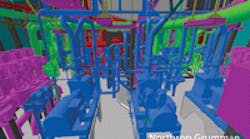Nissan North America's next-generation minivan, the 2012 NV, might have looked great in the design stage. But to truly understand how it would play out in the physical world, engineers climbed into a 3-D virtual universe and simulated passengers of various sexes, heights and weights climbing in and out of their seats from a variety of angles repeatedly.
Nissan has employed 3-D simulation for a variety of its design processes, from studying a user loading then unloading a bag of golf clubs, groceries or a surfboard to the ergonomic placement of its key dashboard engine indicators, using virtualization to study its designs from multiple perspectives and make changes accordingly.
"When you're designing something, it's essentially thousands of small decisions, any one of which can cost you money and time," says Dave Pierson, senior design engineer for MAGNET -- The Manufacturing Advocacy & Growth Network, a consulting group that offers design and technology services to small and midsized manufacturers. "Anything that can help you realize those mistakes faster and allow you to correct them sooner in the process is extremely valuable."
Northrop Grumman has taken 3-D simulation onto a mass scale, using Dassault Systemes' Catia software to develop a detailed design for the Gerald R. Ford (CVN 78) Navy aircraft carrier, which meant breaking the ship down into over 400 different design zones and more than 3 million parts.
The CVN 78 was the Navy's first aircraft carrier to be completely designed using a 3-D product model, according to Michael Shawcross, vice president of aircraft carrier construction programs at Northrop Grumman.
The CVN 78's product model included the definition of the ship's geometry and technical definition of the ship's parts, including the procurement, planning and manufacturing data.
"It helps us to forecast parts earlier in the design process," says Shawcross. "When you develop a design for multiple disciplines, involving hundreds of systems being designed into the same space, you have to sequence all of those and have a hierarchy of priority. Doing it in a product model, the computer lines it all up."
The software helped identify areas of overlap where, for example, piping layout might have interfered with maintenance criteria.
Still, there are some limitations to 3-D simulation. Nissan North America, for instance, only uses it on a fraction of its virtual manufacturing processes. While there are a large number of tools available today, such as gloves a user will put on his or her hands that will provide haptic feedback in the design of surfaces and objects, the technology is still not ready for primary design deployment, according to Kurt Beyerchen, Nissan North America's senior manager of human engineering.
"It's still not the same as touching and feeling, say, where the temperature control knob is on a vehicle," says Beyerchen. "I don't know if that will ever be resolved."
Instead, Beyerchen anticipates that instead of virtual reality, more designers will move to what he calls "augmented reality," which combines the 3-D viewing experience with actual objects. As an example, he says, designers could create a foam shape of a designed dashboard, which would then be overlaid with "some of the photo-realistic rendering capability that some of the non-3-D software provides." He adds, "I think that's where the future is going."
For whatever its limitations, MAGNET's Pierson says he is using 3-D simulation on everything from testing candy bar production equipment to the thermal analysis on new forms of grocery packaging to studying the center of gravity on a mechanism as it accelerates and decelerates.
"What I try to explain to my people is I'd like you to fail as much as possible and fail as quickly as possible," says Pierson. "A designer might be making 3,500 different small decisions during the designing of a product. If there are going to be errors, I want them early in the process, when they're cheap to correct, not later."
See Also:
• Lost (and Found) in Translation
• Technology Would Power Cars With Auto Exhaust



